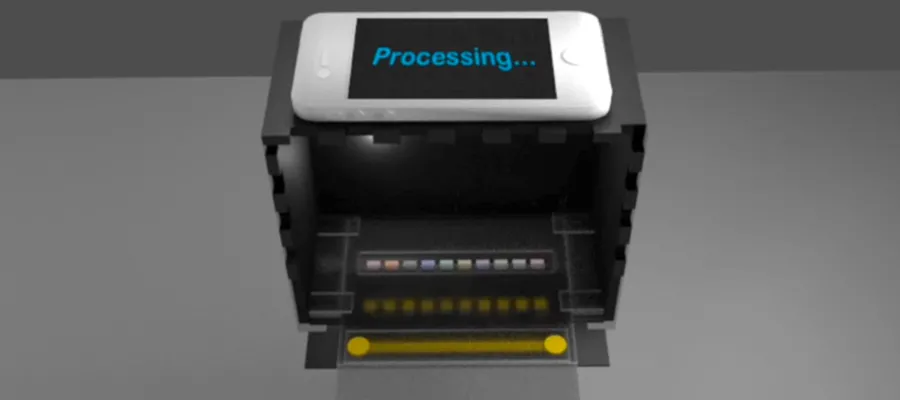
Screenshot of animation by Gennifer Smith: The black box is meant to enable a smartphone camera to capture video that accurately analyzes color changes in a standard paper dipstick in order to detect conditions of medical interest.
Stanford News - May 16th, 2016 - by Shara Tonn
There’s a good reason your doctor asks for a urine sample at your annual checkup. A simple, color-changing paper test, dipped into the specimen, can measure levels of glucose, blood, protein and other chemicals, which in turn can indicate evidence of kidney disease, diabetes, urinary tract infections and even signs of bladder cancer.
The simple test is powerful, but it isn’t perfect: It takes time, costs money and creates backlogs for clinics and primary care physicians. Results are often inconclusive, requiring both patient and doctor to book another appointment. Patients with long-term conditions like chronic urinary tract infections must wait for results to confirm what both patient and doctor already know before getting antibiotics. Tracking patients’ progress with multiple urine tests a day is out of the question.
Some innovators have tried to democratize urine testing by creating a low-cost way to analyze one of medicine’s trusty staples – the urinary dipstick – in any setting, even at home.
Although the test seems simple, do-it-yourself systems can be error prone, said Audrey (Ellerbee) Bowden, assistant professor of electrical engineering at Stanford.
“You think it’s easy – you just dip the stick in urine and look for the color change, but there are things that can go wrong,” she said. “Doctors don’t end up trusting those results as accurate.”
Writing in Lab on a Chip, a journal of the Royal Society of Chemistry, Bowden and Gennifer Smith, a PhD student in electrical engineering, detail their new low-cost, portable device that would allow patients to get consistently accurate urine test results at home, easing the workload on primary care physicians.
Other do-it-yourself systems are emerging, but the Stanford engineers think their approach is inexpensive and reliable, in part because they base their system on the same tried and trusted dipstick used in medical offices.
A history of success
Invented to test blood sugar in 1956, the standard dipstick test is now a paper strip with 10 square pads. Dipped in a sample, each pad changes color to screen for the presence of a different disease-indicating chemical. After waiting the appropriate amount of time, a medical professional – or, increasingly, an automated system – compares the pad shades to a color reference chart for results.
Considering the dipstick as a given, Bowden and Smith designed a system to overcome three main potential errors in a home test: lighting, volume control and timing.
As a color-based test, the dipstick needs consistent lighting conditions. The same color can look different depending on its background, so Smith and Bowden created a black box that covers the dipstick. Its flat, interlocking parts make it easy to mail, store and assemble.
They also tackled volume control. “If you have too little or too much urine on the dipstick, you’ll get erroneous results,” Smith said.
To fix this, the engineers designed a multi-layered system to load urine onto the dipstick. A dropper squeezes urine into a hole in the first layer, filling up a channel in the second layer and ten square holes in the third layer. When the third layer is inserted into the black box, some clever engineering ensures that a uniform volume of urine is deposited on each of the ten pads on the dipstick at just the right time.
Finally, a smartphone is placed on top of the black box with the video camera focused on the dipstick inside the box. Custom software reads video from the smartphone and controls the timing and color analysis.
To perform the test a person would load the urine and then push the third layer into the box. When the third layer hits the back of the box, it signals the phone to begin the video recording at the precise moment when the urine is deposited on the pads.
Timing is critical to the analysis. Pads have readout times ranging from 30 seconds to 2 minutes. Once the two minutes are up, the person can transfer the recording to a software program on their computer. For each pad, it pulls out the frames from the correct time and reads out the results.
Consult with your phone
In the future, the engineers would like to design an app that would do the analysis on the phone and then send results directly to the doctor.
Meanwhile, they are working with the Stanford Office of Technology Licensing to see whether and how the idea might be commercialized, either as a home test in developed nations or as a baseline medical instrument in areas that don’t have easy access to well-stocked clinics.
“It’s such a hassle to go into the doctor’s office for such a simple test,” said Smith. “This device can remove the burden in developed countries and in facilities where they don’t have the resources to do these tests.”
The paper is titled “Robust dipstick urinalysis using a low-cost, micro-volume slipping manifold and mobile phone platform.” Funding for this research came from the National Institutes of Health, the Rose Hills Foundation Graduate Engineering Fellowship, the Electrical Engineering Department New Projects Graduate Fellowship, the Oswald G. Villard Jr. Engineering Fellowship, the Stanford Graduate Fellowship and the National Science Foundation Graduate Research Fellowship.

